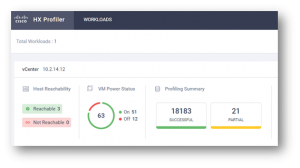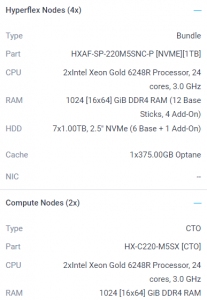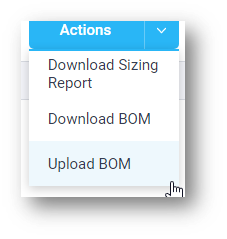Tuesday, 9 May 2023
Disaster Recovery Solutions for the Edge with HyperFlex and Cohesity
Thursday, 10 March 2022
Focus on HyperFlex: Sizing A New Cluster Using the Sizer and Profiler Tools
In this ‘Focus on HyperFlex’ blog, we’ll zero-in on different aspects of the Cisco HyperFlex (‘HX’) hyperconverged system and ways to make HX work best for you and your organization. This edition will illustrate on how to size a cluster when you might not have all the details of the workload worked out. In this situation, HyperFlex Profiler is the right approach to learn more about the workloads.
During my time in sales, teams often asked me to size a HyperFlex cluster and provide a customer quote. It was customary to have many more questions than the team or customer could answer about the application. Normally, they would provide me with an Excel sheet with some CPU and memory values. That is a great start, and it gave me deep insight into the customer’s application. However, an application profile is not only about averages of CPU and memory. There are several more parameters needed, including the performance and latency peaks. With the customer’s permission, I would run a HyperFlex Profiler in their environment to gain more information about their application. Before installing the OVA on their vCenter, I would explain what HyperFlex Profiler is and how it helps with sizing their new HyperFlex environment.
HyperFlex Profiler
If there is no historical insight into the potential clustered application environment, then start with HyperFlex Profiler. HyperFlex Profiler will gather data on the vCenter environment and consolidate that mass of data to a single, easily digestible file. This file will quickly size the cluster after importing it into the HyperFlex Sizer tool and paint a clearer picture of the environment and workloads.
However, profiling the environment is not a quick hit in a short period of time. The best approach is to run the HyperFlex Profiler for at least seven days or, preferably, 30 days. A longer measuring period ensures you capture data when “end of the month reports” are run. Of course, don’t just measure the environment during a weekend when there is little traffic! Be sure to capture at least one logical business cycle for that application.
The HyperFlex Profiler is an OVA installed on a VMware environment. The only configuration is to provide (read-only) access to the vCenter environment and define which servers the HyperFlex Profiler will monitor. Multiple servers and/or clusters can be selected. For environments running different types of workloads, it is recommended to isolate them by selecting the servers in their environments – for instance, the VDI or the SQL environment. Of course, selecting all servers and workloads is also an option. Keep in mind that you will have more overhead this way.
When it is monitoring the environment, you will see the following:
HyperFlex Sizer
Create an estimate
Thursday, 3 September 2020
VDI Rapid Deploy – Enable Remote Work Fast!
When we were all suddenly thrown into the situation where we ALL had to work remotely, no one was prepared. The pandemic created demand for remote work that was unprecedented, unexpected, and impossible to support with existing infrastructures. Demands for collaboration tools like Cisco WebEx and Cisco WebEx Teams skyrocketed. Demands for secure access to corporate networks went through the roof. Cisco AnyConnect secure VPN services, Cisco DUO two factor authentication and Cisco Umbrella secure DNS service filled the secure access requirements.
We’ve now come to find that those foundational tools don’t provide the full remote work experience that you and I need as we transition into long-term remote work. We need access to all our applications and all our data. And it’s critical that the applications and data be in the same physical location for acceptable performance.
Enter Virtual Desktop Infrastructure, or “VDI” for short. VDI has been around for a long time, as far back as the mid-80s. The technology is continuously evolving and improving. It’s considered a mainstream, virtually risk-free technology for supporting secure remote work. VDI is deployed at scales of 100,000 users or more at some of the largest organizations on the planet. It is also deployed at scales as low as 400 users, thanks to the economics of hyperconvergence.
VDI brings some very key benefits for remote work to organizations and end users:
Saturday, 1 August 2020
Introducing the Cisco C240 SD M5 Server for the Performance Edge
Supporting applications at the edge with high-performance, easy to manage UCS C240 SD M5 Server
As more data and processing needs exist and are growing rapidly at the edge, providers and customers are exploring methods to avoid the bandwidth, latency, and overall costs of backhauling content to the traditional data center. Instead, the industry is moving towards enabling the more intense computational needs closer to where this data and content is gathered and presented.
According to IDC (1), 50% of new enterprise IT infrastructure deployed will be at the edge by 2023, and there will be an 800% increase in the number of apps at the edge by 2024. The industry is already looking for innovative methods to uniformly operate in this greatly scaled out environment.
We talked with many customers looking at these needs in areas such as service providers, hosting providers, enterprise branch, retail, defense, and many others, they have shared some common requirements:
◉ Solution optimized for a compact and tactical environment
◉ Simple on-boarding to management and orchestration tools by non-IT personnel
◉ Autonomous operations, with an ability for simple periodic updates
◉ Easy access and maintenance by non-IT personnel
◉ Performance that traditionally resides within today’s Data Center
◉ Enhanced security to operate within shared-use multi-access facilities
◉ Flexible options along with global 24×7 support
Cisco used these customer requirements to guide us as we developed a new UCS server platform for our customers. Our teams have been working hard on this problem and we are excited to announce the new Cisco C240 SD M5 server.
Introducing the Cisco UCS C240 SD M5
Customer Focused, Operate at Scale
Friday, 22 November 2019
Modernizing to Oracle 19c with Hyperconverged Infrastructure
Additional optimizations in Oracle Database 19c include real-time statistics for all operations and the ability to automatically quarantine problematic sequel. It also includes key unique innovations for core enterprise capabilities. For a lot of customers who run standby databases, Oracle 19c accepts updates to those standby databases, thereby turning the standby from a read-only to a read-mostly asset. In order to deal with streaming data or to have IOT type workloads, 19c provides a new in-memory rows store and API to provide very high speed and high volume data ingest.
Below is the list of some of the new features in Oracle Database 19c:
◉ General – Flashback Standby database when primary database is flashed back
◉ Performance – SQL Quarantine
◉ RAC & Grid Infrastructure – Zero-Downtime Oracle Grid infrastructure patching
◉ Availability – Dynamically change Fast-Start Failover (FSFO) target
◉ Application Development – REST Enabled SQL Support
◉ Automatic Indexing
◉ Database IN-Memory
◉ REAL-TIME Statistics Collections
◉ High Availability
Oracle on A Hyperconverged Infrastructure
The rapidly emerging world of hyperconverged infrastructure (HCI) promises many technical and financial benefits. The marketplace has been quick to recognize and validate the advantages of HCI, which combines the main features of a three-tier architecture – compute, storage, and networking – into a single solution. Having superior, vendor-supplied software is crucial to facilitate easy and efficient management of resources. In addition to managing the essentials of compute, storage and networking layers, HCI solutions also provide features to handle DR and the ability to scale up, with additional nodes as needed.
For an Oracle customer, the benefits of HCI from a technical optimization perspective are clear. You reduce unused hardware capacity through better resource management, eliminate network devices, and scale up your Oracle deployments easily and rapidly in response to rising demand. Adding nodes and moving workloads becomes seamless.
Various considerations while choosing an HCI environment:
◉ A Simple, integrated software stack which allows to do more with less
◉ Consistent, high performance that satisfies demanding business critical applications
◉ Flexible deployment models that align IT expertise with business priorities
◉ Advanced automation capabilities that enable IT agility
◉ Hypervisors that offer confidence and lower risk
Cisco’s Hyperconverged Infrastructure
Businesses across all verticals are seeing benefits behind this tight integration with virtual technologies as well. HCI reduces complexity and fragmentation around having to manage resources sitting on heterogeneous systems; it can reduce data center footprints; and it can greatly reduce deployment risks with validated deployment architectures.
There’s clear demand in the market. Consider this: according to the latest Gartner Magic Quadrant for Integrated Systems report, “hyperconverged integrated systems will represent over 35 percent of the total integrated system market revenue by 2019.” This makes it one of the fastest-growing and most valuable technology segments in the industry today.
With a co-engineered hardware and software solution Cisco has become a Gartner Magic Quadrant leader in HCI with Cisco HyperFlex. Taking in all the considerations listed above while choosing an HCI environment, Cisco’s HyperFlex is a great solution and a great technology to consider while running oracle on. That said, there are numerous critical features that set this technology apart from any other HCI solution out there. One of those aspects revolves around the fact that HyperFlex comes with full network fabric integration. This type of integration allows administrators to create QoS policies and even manage vSwitch configurations that scale throughout the entire fabric interconnect architecture. This approach provides data reliability and fast database performance. Cisco HyperFlex integrates servers, storage systems, network resources, and storage software to provide an enterprise-scale environment for an Oracle Database deployment. This highly integrated environment provides reliability, high availability, scalability, and performance to handle large-scale transactional workloads.
Oracle Databases and Real Application Clusters (RAC) are the core of many enterprise applications, including online transaction processing (OLTP), data warehousing, business intelligence, report generation, and online analytical processing (OLAP). As the amount and types of data increase, you need flexible and scalable systems with predictable performance to address database sprawl. By deploying Cisco HyperFlex with All Flash or All NVMe nodes, you can run your Oracle Database and RAC deployments on an agile platform that delivers insight in less time and at less cost.
Cisco HyperFlex systems with Oracle Database and RAC:
◉ Closely match the needs of databases and applications
◉ Reduce Storage footprint
◉ Optimize storage costs
◉ Deliver predictable database performance
◉ Keep enterprise applications and database available
◉ It provides 71 percent more I/O operations per second (IOPS) and 37 percent lower latency than our previous-generation all-flash node.
◉ Also provides 15% more storage efficiency due to less storage needed when using the Cisco HyperFlex Acceleration Engine.
All-NVMe solutions support the most latency-sensitive applications with the simplicity of hyperconvergence. Our solutions provide the first fully integrated platform designed to support NVMe technology with increased performance and RAS.
As mentioned above, Cisco HyperFlex systems best suites Oracle Database and RAC deployments, best performance at a cost of very low latency. To help you deploy Oracle 19c and Oracle RAC, we deployed Oracle 19c Database on a 4 node HyperFlex cluster and tested it with various configuration profiles. Below are the links to the Oracle whitepaper references containing validation results tested internally. From the test results, it’s clearly evident that Cisco HyperFlex systems can handle OLTP highly intensive workloads by delivering best performance at a very low cost and latency.
Wednesday, 30 October 2019
The SD-WAN Factor: Partnering for Success
The “Katalyst” for Selecting Cisco SD-WAN
When Katalyst selects a new product to deploy, whether internally or at a customer site, there’s little room for error; getting it right the first time isn’t just important, it’s a must. Katalyst’s stringent decision criteria looks at a number of attributes, including management, ease of use, cost savings, programmability, stability, and more.
SD-WAN end-users realize better SaaS application performance, branch offices and acquisition sites are brought online in minutes rather than hours or even days, and businesses are seeing cost savings through the utilization of broadband links. IT teams are also seeing a huge benefit with a centralized console (vManage) that provides them with a comprehensive view of all devices and clients connected to the network. They can make configuration changes, add security policies, see the health of their links and much more directly from within vManage.
And Katalyst’s track record, together with Cisco, is able to drive change, and customers are taking notice. A recent IDC report states that, “Cisco holds the largest share of the SD-WAN infrastructure market, fueled by its extensive routing portfolio that is used in SD-WAN deployments…”
SD-WAN Tastes Pretty Good!
Simplifying SD-WAN
SD-WAN Security
Saturday, 19 October 2019
Introducing the Cisco Intersight Mobile App for Data Center Visibility on the Go
The iOS version of the app is available now in the Apple App Store and the Android version will be available in the Google Play Store soon.
How does it work?
A quick peek at the appropriate dashboard can reveal Server, HyperFlex Cluster, or Fabric Interconnect views for your environment. These dashboards provide high-level roll-ups showing health, inventory, model, and alarm summaries.
How are my servers doing?
HyperFlex Storage Capacity on the Go
This is just the beginning for Intersight’s Mobile App. With this introductory version of the mobile app, users get:
◈ On-the-go health and inventory detail
◈ HyperFlex capacity detail
◈ Status and monitoring of Intersight-driven requests
Saturday, 6 October 2018
Enabling Enterprise-Grade Hybrid Cloud Data Processing with SAP and Cisco – Part 2
Friday, 28 September 2018
Cisco Intersight: AI-Driven IT Operations Strategy
A New Era in Operations Management
“Work smarter, not harder” is critical to improving IT efficiency. Organizations are adopting a multicloud strategy, so you need scalable and consistent management across data centers, private clouds, edge, and branch environments. Cisco Intersight delivers this consistent management, automation and policy enforcement across a variety of servers and hyperconverged infrastructure (HCI). It helps you work smarter by delivering proactive support and actionable intelligence through artificial intelligence (AI) and machine learning (ML), so that you can proactively manage complex environments and reduce risk.
Traditional IT operations management tools are deployed on-premise, they are vendor and device focused, difficult to maintain, and have limited ability to scale. We introduced a new era of systems management with Cisco Intersight. It provides the simplicity of software as a service (SaaS) with unlimited scalability. Intersight is enhanced by AI and ML to provide users with actionable intelligence.
Requirements for AI Operations
Open and Unified AI Ops
The Four Benefits of AI Operations
Friday, 30 March 2018
Cisco UCS and HyperFlex for AI/ML Workloads in the Data Center
Monday, 15 January 2018
Hyperconvergence doesn’t get any easier
Saturday, 17 June 2017
Cisco Hyperflex: The Time for HCI Compromise is Over
While the concept has only been mainstream for a few years, HCI is the fastest-growing segment of the market for integrated systems.









































